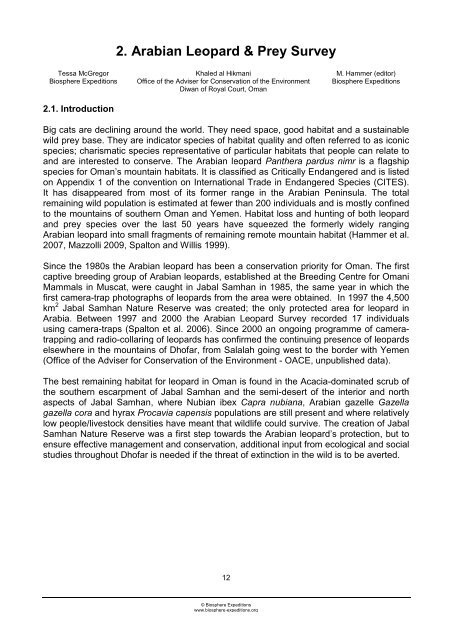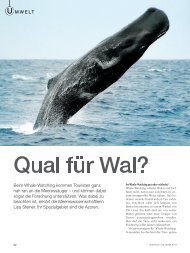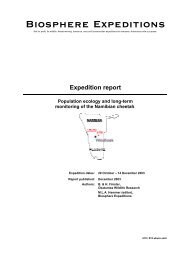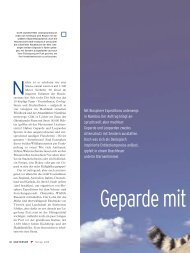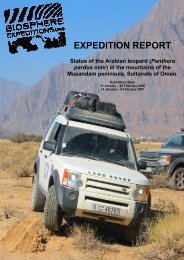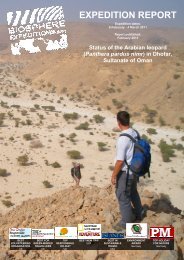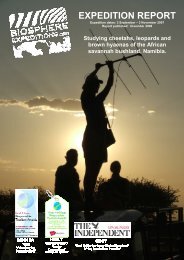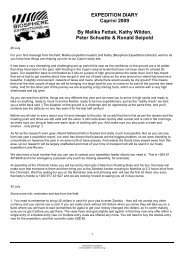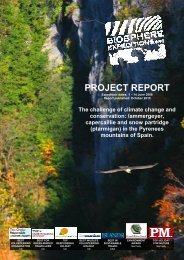EXPEDITION REPORT - Biosphere Expeditions
EXPEDITION REPORT - Biosphere Expeditions
EXPEDITION REPORT - Biosphere Expeditions
Create successful ePaper yourself
Turn your PDF publications into a flip-book with our unique Google optimized e-Paper software.
Tessa McGregor<br />
<strong>Biosphere</strong> <strong>Expeditions</strong><br />
2.1. Introduction<br />
2. Arabian Leopard & Prey Survey<br />
Khaled al Hikmani<br />
Office of the Adviser for Conservation of the Environment<br />
Diwan of Royal Court, Oman<br />
12<br />
© <strong>Biosphere</strong> <strong>Expeditions</strong><br />
www.biosphere-expeditions.org<br />
M. Hammer (editor)<br />
<strong>Biosphere</strong> <strong>Expeditions</strong><br />
Big cats are declining around the world. They need space, good habitat and a sustainable<br />
wild prey base. They are indicator species of habitat quality and often referred to as iconic<br />
species; charismatic species representative of particular habitats that people can relate to<br />
and are interested to conserve. The Arabian leopard Panthera pardus nimr is a flagship<br />
species for Oman’s mountain habitats. It is classified as Critically Endangered and is listed<br />
on Appendix 1 of the convention on International Trade in Endangered Species (CITES).<br />
It has disappeared from most of its former range in the Arabian Peninsula. The total<br />
remaining wild population is estimated at fewer than 200 individuals and is mostly confined<br />
to the mountains of southern Oman and Yemen. Habitat loss and hunting of both leopard<br />
and prey species over the last 50 years have squeezed the formerly widely ranging<br />
Arabian leopard into small fragments of remaining remote mountain habitat (Hammer et al.<br />
2007, Mazzolli 2009, Spalton and Willis 1999).<br />
Since the 1980s the Arabian leopard has been a conservation priority for Oman. The first<br />
captive breeding group of Arabian leopards, established at the Breeding Centre for Omani<br />
Mammals in Muscat, were caught in Jabal Samhan in 1985, the same year in which the<br />
first camera-trap photographs of leopards from the area were obtained. In 1997 the 4,500<br />
km 2 Jabal Samhan Nature Reserve was created; the only protected area for leopard in<br />
Arabia. Between 1997 and 2000 the Arabian Leopard Survey recorded 17 individuals<br />
using camera-traps (Spalton et al. 2006). Since 2000 an ongoing programme of cameratrapping<br />
and radio-collaring of leopards has confirmed the continuing presence of leopards<br />
elsewhere in the mountains of Dhofar, from Salalah going west to the border with Yemen<br />
(Office of the Adviser for Conservation of the Environment - OACE, unpublished data).<br />
The best remaining habitat for leopard in Oman is found in the Acacia-dominated scrub of<br />
the southern escarpment of Jabal Samhan and the semi-desert of the interior and north<br />
aspects of Jabal Samhan, where Nubian ibex Capra nubiana, Arabian gazelle Gazella<br />
gazella cora and hyrax Procavia capensis populations are still present and where relatively<br />
low people/livestock densities have meant that wildlife could survive. The creation of Jabal<br />
Samhan Nature Reserve was a first step towards the Arabian leopard’s protection, but to<br />
ensure effective management and conservation, additional input from ecological and social<br />
studies throughout Dhofar is needed if the threat of extinction in the wild is to be averted.


